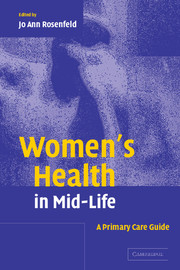Book contents
- Frontmatter
- Contents
- List of contributors
- 1 Introduction
- Part I Health promotion
- Part II Hormonal changes
- Part III Disease prevention
- Part IV Cancer prevention
- 16 Breast cancer: screening and prevention
- 17 Cervical cancer: prevention, screening, and early detection
- 18 Endometrial cancer: prevention, screening, and early detection
- 19 Ovarian cancer: prevention, screening, and early detection
- 20 Colon, lung, and skin cancer: screening and prevention
- 21 Common gastrointestinal and urinary problems
- Index
- References
18 - Endometrial cancer: prevention, screening, and early detection
from Part IV - Cancer prevention
Published online by Cambridge University Press: 21 August 2009
- Frontmatter
- Contents
- List of contributors
- 1 Introduction
- Part I Health promotion
- Part II Hormonal changes
- Part III Disease prevention
- Part IV Cancer prevention
- 16 Breast cancer: screening and prevention
- 17 Cervical cancer: prevention, screening, and early detection
- 18 Endometrial cancer: prevention, screening, and early detection
- 19 Ovarian cancer: prevention, screening, and early detection
- 20 Colon, lung, and skin cancer: screening and prevention
- 21 Common gastrointestinal and urinary problems
- Index
- References
Summary
Case: T.H. is a 48-year-old woman who has not had a menstrual period in seven months, when she comes into the office with a sudden heavy menstrual period that has already lasted ten days. She has had to use three boxes of pads, and up to one pad an hour at its most heavy flow. She has had no pain but wonders what is happening to her. She does not smoke, is moderately overweight (body mass index (BMI) 31.0), and had normal thyroid tests three months ago.
Introduction
Endometrial carcinoma is one of the most common cancers in women, with an incidence of 2.6%. It ranks behind breast cancer and colon cancer in incidence, but it is seen more commonly than ovarian cancer. Endometrial carcinoma may be preceded by endometrial hyperplasia. Hyperplasia, as a potentially precancerous condition, and endometrial carcinoma meet criteria for conditions that benefit from early detection. Effective, reasonably tolerated treatments of endometrial hyperplasia and early-stage endometrial carcinoma are available. Early treatment has a significant impact on outcome.
Endometrial carcinoma and hyperplasia present most frequently with abnormal uterine bleeding, either in the premenopausal and perimenopausal age group, or in postmenopausal women. This is a common complaint in mid-life women. The presence of vaginal bleeding is also monitored in many women during mid life by clinicians concerned with the side effects of hormonal therapy or in high-risk women, such as those undergoing treatment with tamoxifen following breast cancer diagnosis.
Keywords
- Type
- Chapter
- Information
- Women's Health in Mid-LifeA Primary Care Guide, pp. 293 - 310Publisher: Cambridge University PressPrint publication year: 2004



